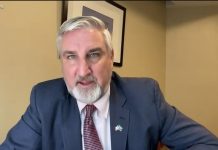An often-asked question about efforts to save the lives of drug addicts surfaced again during a Columbus conference on substance abuse.
Why do police continue to administer the drug-overdose antidote naloxone, described as a get-out-of-dying-free card to addicts who repeatedly take advantage of its availability?
“Here’s the thing,” said Columbus Police Department Sgt. Jay Frederick, a presenter at the Desperate Households conference hosted by the Bartholomew County Substance Abuse Council, “it’s the difference between life and death.
“I can tell you that 0 percent of the people who die in an overdose succeed in recovery,” he told his audience of about 300 people at Westside Community Church.
[sc:text-divider text-divider-title=”Story continues below gallery” ]
Saving a life is pretty simple, Frederick said of using naloxone to help an individual overdosing on opioids.
“I understand in the broad picture, you want to be able to flip a switch and solve the problem,” he said of the heroin epidemic that has overtaken Bartholomew County and the rest of the nation in the past few years.
“But right now, the tourniquet is Narcan (and its generic version, naloxone), and it’s being used as the life-saving component,” he said.
“We are here to protect and serve,” said Bartholomew County Sheriff’s Department Capt. David Steinkoenig, another presenter. “I am not allowed to decide who I want to protect and serve.”
The half-day conference outlined how the nationwide opioid epidemic evolved and how serious it has become locally.
Nine people have died so far this year from heroin overdoses in Bartholomew County, a primarily rural, agriculturally dominant place with Columbus as a progressive, community-minded, growing city at its center. Six of those deaths occurred in the first three months of the year, according to the Bartholomew County coroner’s office.
More than 130 others have overdosed this year, only to be saved when naloxone was administered by first responders, Frederick said.
The Columbus Police Department began to see significant increases in heroin overdoses in 2013, when three heroin deaths were reported, followed by five in 2014. Just one heroin-related death was reported in 2015, with the reduction attributed to wider availability of naloxone.
Just before the conference began, Columbus police announced the arrest of two people possibly connected to a rash of heroin overdoses the weekend of Sept. 17-18. Columbus police officers and sheriff’s deputies were called that weekend to nine overdoses, seven that may have involved tainted heroin — although none of them fatal.
Mixing heroin with fentanyl, a powerful anesthetic used in cancer treatment, or as an elephant tranquilizer, has been mentioned by police in southern Indiana, Kentucky and Ohio as possible reasons for an epidemic of overdoses from late summer to early fall this year.
The sudden rise has been startling. In year-over-year comparisons, overdose calls in Bartholomew County doubled in September and October.
Ed Reuter, director of Bartholomew County Emergency Operations Center, said participants in the conference could easily grasp the gravity of the drug problem.
“Jay and Dave painted the picture really vividly for the people on the front lines of addiction recovery,” he said. “By being here, they have a more clear and confident knowledge of trends in our community.”
Keynote speaker Scott Watson of Indianapolis, an addictions counselor with Heartland Intervention, talked about strategies for addiction and recovery, focusing on the mindset needed to help someone struggling with recovery.
He asked conference participants to think of an individual affected by addiction and reminded them that behind every one of the addiction numbers, there’s a story and a person.
Attendees made time for the conference to gain personal insight into the trends.
Joy Langdon, Court-Appointed Special Advocate supervisor for Columbus-based Advocates for Children, said she wanted to learn more about opioids and how the drugs are affecting the area she serves. Langdon said she appreciated that the speakers covered the whole spectrum of opioids, not just heroin, and included information about how drugs prescribed by physicians can lead to addictions.
Langdon said she was surprised to learn that one of the first times naloxone was used in Bartholomew County to save an overdose patient, it was someone taking prescription pain medication.
Ronnie Zirkel, a recovery coach with the National Youth Advocate Program in Columbus, said she wanted to get a better understanding how to help her clients in their recovery. She is working to assist 13 teens right now.
Leanne Loutner, a Smith Elementary School counselor, attended to learn about the influences children face and to talk with others who are working with local youth.
“At school we try to teach children about healthy lifestyles. In doing that, it’s important for school staff to know what’s going on in our community and also get to know some of the support that is out there to help,” she said.
Addiction’s origin
Perkinson opened the conference by taking attendees through the history of addictive behavior in the United States, from opioid-addicted housewives in the 1950s, to rise of the drug counter culture in the 1960s to today’s struggles with marijuana, methamphetamine and heroin.One way for the country to find its way out of the heroin crisis is to understand how it developed in the first place, Frederick said.
The police officer started with an explanation of how opioids are produced — the product of residue scraped off poppy pods called opium — and detailing how that is used as the base for painkillers such as morphine and codeine, partially synthetic painkillers such as hydrocodone and oxycodone and fully synthetic painkillers such as methadone and fentanyl.
When he talks with addicts, Frederick said he has heard countless stories of individuals who had a sports injury in high school and were put on long-term painkillers, which were abruptly cut off, leading the person to seek a substitute such as heroin.
While the movement by the medical community to address pain was a noble one, part of that movement resulted in prescribing lots of painkillers, Frederick said. Pain clinics began sprouting up and Florida became ground zero for businesses that weren’t really legitimate pain clinics but basically homes for drug dealers, Frederick said.
Describing hydrocodone, a combination of opioid and a substance such as acetominiphen, as the gateway drug for many addicts, Frederick said doctors would prescribe it “like candy” with refills for six months at a time available just by calling in.
“Somehow we thought that combination was less prone to addiction,” he said. “We were wrong. It had the same potential for abuse and addiction.”
The federal government has since made hydrocodone a higher class drug, meaning it cannot be refilled over the phone and cannot be prescribed long-term. But when the government cracked down on prescription opioid abuse, many people turned to the cheap alternative of heroin to fill their addiction.
Frederick said a tenth of a gram of heroin, the usual purchase around the Columbus area, goes for about $20, but the cost is market-driven. Dealers award buyers who purchase in bulk with a better rate.
But most recently, heroin buyers can’t be sure what they’re getting and whether it has been cut with fentanyl.
America, with 4.6 percent of the global population, consumes two-thirds of the world’s illegal drugs, 80 percent of the world’s opioid analgesics and 99 percent of the world’s hydrocodone, Frederick said.
At first, he didn’t believe the hydrocodone statistic, but he confirmed it and now includes it to punctuate just how serious the problem is.
Steinkoenig, who worked narcotics for seven years, told listeners he would not sugar coat anything about the kinds of drugs being abused in Bartholomew County. As a captain over the sheriff’s department uniform division, he sees every report deputies file.
Eye-opening assignment
The officer’s first revelation when working narcotics for former Sheriff Mark Gorbett was being told to report to work at 8 a.m., rather than a night shift.“I thought he was crazy — 8 a.m.? I thought, ‘Who buys drugs during the day?’ “ he said.
But Steinkoenig assured the crowd that drugs are being sold throughout the day in Bartholomew County, from school parking lots to pharmacy aisles and other locations.
And while heroin and opioids are serious problems, meth also continues to be a dangerous drug in the county — despite strong efforts to remove it, he said.
Between 2002 and 2014, Bartholomew County had 636 meth labs that were discovered and cleaned up.
“We had more meth labs than any other county in the state,” Steinkoenig said.
With ingredients easy to collect, anyone could become a drug-maker.
At one point, narcotics officers went through a big-box store buying most, if not all, of the items needed to make meth, including cold medicine at the pharmacy, and no one blinked an eye, Steinkoenig said.
Due to law enforcement’s ongoing focus on eradicating labs, only one actual operating meth lab has been found in Bartholomew County this year, although some remnants of labs have been found along roadsides, he said.
Drug dealers have decided it’s cheaper and easier to import methamphetamine from California and Mexico as opposed to making it. As a result, the sheriff’s department is working directly with the federal Drug Enforcement Administration to combat drugs coming into the county.
The sheriff’s department has assigned a deputy to work directly with the DEA, and Steinkoenig said Sheriff Matt Myers has taken some heat for that.
“They argue, ‘Why is one of your guys working in Indy?’ And some might think that’s a valid argument, but the dope is coming from somewhere, folks,” Steinkoenig said.
Most of the illegal drugs in Columbus come in from Chicago, Indianapolis and Cincinnati, he said.
“When our guy is working with the DEA, he’s going after dope bound for Columbus,” Steinkoenig said. “If we can play a part to prevent dope from getting here, period, that’s better. “And we can use those federal resources to help us get dope out of Columbus.”




